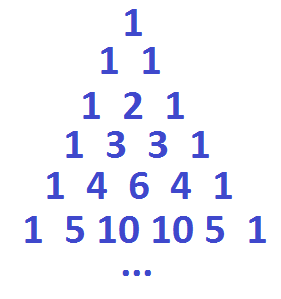The Astounding Power of Area
2.8 EXTRA: The Binomial Theorem
[A full and proper discussion of the Binomial Theorem appears in Lesson 3.5 of the Permutations and Combinations course. All counting formulas and its connections to Pascal’s Triangle are explained and derived there.]
When I was in school students I was required to memorize the formulas
\(\left(x+y\right)^{2}=x^{2}+2xy+y^{2}\)
\(\left(x+y\right)^{3}=x^{3}+3x^{2}y+3xy^{2}+y^{3}\)
One can easily add to this list
\(\left(x+y\right)^{1}=x+y\)
and even
\(\left(x+y\right)^{0}= 1\).
If one had the patience one can check
\(\left(x+y\right)^{4}=x^{4}+4x^{3}y+6x^{2}y^{2}+4xy^{3}+y^{4}\).
The connection to Pascal’s triangle is striking.

Why do the coefficients that occur when expanding \(\left(x+y\right)^{n}\) seem to match the entries of the \(n\)th row of Pascal’s Triangle?
To answer this, recall the act of expanding brackets from lesson 1.3 of this course: select one term from each set of parentheses and make sure to collect all possible combinations. For example, we see
\(\left(a+b+c\right)\left(p+q+r\right)\left(s+t+u+v\right)\left(x+y\right) = axps+ayqu+cxps+\ldots\).
(There will be \(72\) terms in the sum.)
Now imagine expanding the quantity \(\left(x+y\right)^{5}=\left(x+y\right) \left(x+y\right) \left(x+y\right) \left(x+y\right) \left(x+y\right)\).
The term \(x^{5}\) will appear once by choosing the term \(x\) from each set of parentheses.
The term \(x^{4}y\) will appear five times:
once by choosing \(x\),\( x\), \(x\) ,\(x\) and then \(y\),
once by choosing \(x\), \(x\), \(x\), \(y\), and then \(x\),
once by choosing \(x\), \(x\), \(y\), \(x\), and then \(x\),
once by choosing \(x\), \(y\), \(x\), \(x\), and then \(x\),
once by choosing \(y\), \(x\), \(x\), \(x\), and then \(x\).
That is, \(x^{4}y\) will appear the same number of times as it is possible to arrange four \(x\)s and one \(y\). As we see from our study of counting here this can be done \(\dfrac{5!}{4!1!}=5\) ways, which is an entry of the fifth row of Pascal’s triangle (counting its top as the zeroth row).
The term \(x^{3}y^{2}\) will appear as many times as it is possible to arrange three \(x\)s and two \(y\)s, that is, \(\dfrac{5!}{3!2!}=10\) times.
The term \(x^{2}y^{3}\) ten times, the term \(xy^{4}\) five times, and the term \(x^{5}\) once.
We have:
\(\left(x+y\right)^{5}=x^{5}+5x^{4}y+10x^{3}y^{2}+10x^{2}y^{3}+5xy^{4}+y^{5}\).
The numbers \(1\), \(5\), \(10\), \(10\), \(5\), \(1\) are the entries of the fifth row of Pascal’s triangle.
In general, the entry on the \(n\)th row of Pascal’s Triangle \(a\) places in from the left and \(b\) places in from the right (here \(a+b=n\)) is \(\dfrac{n!}{a!b!}\), and this matches the number of ways to arrange \(a\) \(x\)s and \(b\) \(y\)s and so is the coefficient of \(x^{a}y^{b}\) after expanding \(\left(x+y\right)^{n}\).
THE BINOMIAL THEOREM
\(\left(x+y\right)^{n}=x^{n}+\dfrac{n!}{\left(n-1\right)!1!}x^{n-1}y+\dfrac{n!}{\left(n-2\right)!2!}x^{n-2}y^{2}+\ldots+\dfrac{n!}{\left(a\right)!b!}x^{a}y^{b}+\ldots+y^{n}\).
The coefficients are the entries of the \(n\)th row of Pascal’s Triangle.
Because of this result, the entries of Pascal’s Triangle, \(\dfrac{n!}{a!b!}\), are called binomial coefficients.
EXERCISE: What is the trinomial theorem: \(\left(x+y+z\right)^{n} = \ldots\)?
Resources
Books
Take your understanding to the next level with easy to understand books by James Tanton.
BROWSE BOOKS![]()
Guides & Solutions
Dive deeper into key topics through detailed, easy to follow guides and solution sets.
BROWSE GUIDES![]()
Donations
Consider supporting G'Day Math! with a donation, of any amount.
Your support is so much appreciated and enables the continued creation of great course content. Thanks!
Ready to Help?
Donations can be made via PayPal and major credit cards. A PayPal account is not required. Many thanks!
DONATE![]()


